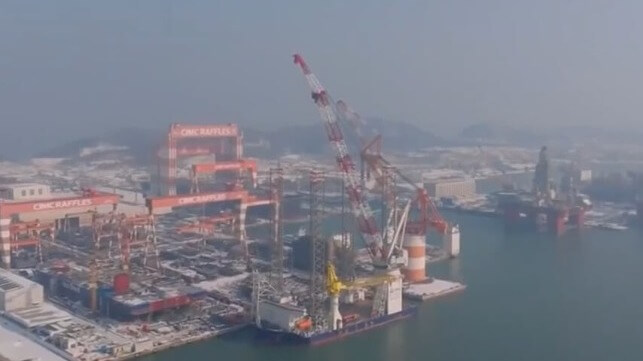Giant 20 MW-Ready Wind Turbine Vessel Heads Out on Sea Trials

China's CIMC Raffles is now testing out the high-spec wind turbine installation vessel Boqiang 3060, one of the largest and most capable vessels of its kind. The name references a government goal to achieve peak carbon emissions by 2030 and carbon neutrality by 2060 (30-60).
The 3060 is designed to solve a uniquely Chinese problem: installing turbines in the 16 MW-plus class. Wind turbines of this size only exist in China, and they require outsize WTIVs for installation.
The 3060's jackup legs can work in water depths of up to 230 feet, the economical maximum for bottom-fixed turbine foundations. It is designed to transport three full sets of 16 MW turbines at a time, and can carry all the components of an entire tower. According to state media, it should have a wide enough operating window that it will be able to work about 200 days out of the year in China's main offshore wind regions.
Perhaps most importantly, the Boqiang 3060 is upgrade-ready to install turbines of up to 20 MW. This mega-size class does not yet exist, but it is the next frontier for Chinese turbine builders. The components will be heavy and tall enough to require a new generation of WTIVs.
 Boquiang 3060 at full loadout with three sets of turbine components (file image courtesy CIMC Raffles)
Boquiang 3060 at full loadout with three sets of turbine components (file image courtesy CIMC Raffles)
China is the world's dominant force in offshore wind, with 30 gigawatts installed - the same as all of Europe - and enough momentum to double that number within the next two years. Its three leading turbine manufacturers are all building 16-megawatt models - bigger than all Western competitors - and have an estimated 20 percent price advantage. Experts on the Chinese grid suggest that the pricing (when factoring in unwritten subsidies and favorable loan terms) is already commercially competitive with carbon-based power sources on the Chinese market. The industry also has powerful political tailwinds behind it, driven by provincial targets for green power generation.
German chemical giant BASF, which has worked with turbine builder Mingyang on projects in China's domestic market, believes that the technology and quality found in the ring-fenced Chinese offshore wind sector is superior.
“The Chinese are technically better than us, and they are also more cost-effective than us,” BASF chairman Martin Brudermüller told Frankfurter Allgemein earlier this year. “They have simply become good with their products.”
